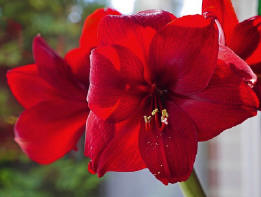(1/31) Sometimes inspiration is found in the most unexpected places. I canít go outside with the dog, take the compost out, go for a walk, or drive down a highway without seeing something that excites me. This week, all I had to do was step into my root cellar. One of my amaryllis bulbs was coming out of dormancy.
Years ago, my friend Lynn gave me an amaryllis bulb kit. It grew enormous, striking red flowers that brightened my home and my spirit. Ever since then, I have maintained the ritual of caring for that bulb and the many offsets that it has produced.
Amaryllis are exceptionally easy to grow. Select bulbs that are firm and have no obvious signs of decay. The pot must have good drainage and should be approximately one inch in diameter larger than the bulb itself. Use a well draining potting mix and set the bulb so the top half to third of the bulb is above the soil line. Place the pot in a brightly lit location,
preferably with southern exposure. Begin watering and the flower stalks will emerge. When the flowers open, remove the anthers (the male portion of the flower where the pollen is produced) to avoid stains on fabric and carpets. Once flowers fade, remove the flower stalks so that only the strappy leaves remain.
 Although the plants can remain indoors, you will have the best chance of the bulbs re-blooming if they are moved outdoors for the summer. After all danger of frost has passed, begin to acclimate them by moving them into a shady location first, gradually increasing the amount of
daylight they receive until they get at least six hours of full sun per day. Use an all-purpose fertilizer according to label directions during the growing season.
Although the plants can remain indoors, you will have the best chance of the bulbs re-blooming if they are moved outdoors for the summer. After all danger of frost has passed, begin to acclimate them by moving them into a shady location first, gradually increasing the amount of
daylight they receive until they get at least six hours of full sun per day. Use an all-purpose fertilizer according to label directions during the growing season.
Amaryllis benefit from a period of rest in order to re-bloom. Before the first frost, bring them indoors to a dark location, preferably between 50-60 degrees. Stop watering the bulbs and allow them to go into dormancy on their own. Do not remove the leaves until they have withered and turned brown. After 8-10 weeks, the bulbs may begin to come out of dormancy on their
own. Check them periodically for signs of growth. If buds are beginning to appear, bring them indoors to a sunny location and begin watering regularly.
Amaryllis like to be pot-bound for best bloom performance so they donít need to be repotted except every 3-4 years. If, however, you have offsets that begin to develop, the bulbs can be removed from the pots and offsets separated and planted following a period of dormancy. In time, they too will bloom. .
For gardeners, it can be difficult to wait for the first blooms of spring. If, however, you decide to grow amaryllis, you may not need to wait quite so long to experience the thrill of seeing the first blossoms of spring emerge, albeit indoors. Although I know that my amaryllis will usually break dormancy sometime in February, I still canít anticipate the exact date
when I will step into the root cellar to fetch a dog doo shovel and be rewarded with the joyful surge of adrenaline that comes with seeing my first bulb of the season break dormancy. Thanks, Lynn.
Read other articles on house plants